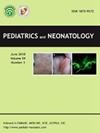Confluence of newborn's sex and their mother's characteristics resulting in fetal macrosomia among Indian neonates
IF 2.3
4区 医学
Q2 PEDIATRICS
引用次数: 0
Abstract
Background
A newborn's birth weight ≥4000 g is defined as fetal macrosomia, which is recognized as a reproductive and serious child health concern.
Objectives
Our study aims to reveal existence of any connection between maternal factors and newborn sex in giving birth to newborn ≥4000 g in an Indian context.
Methods
Data were drawn from the fifth round of National Family Health Survey (NFHS-5). A cross-sectional observational study was carried out with a total of 152,827 children born to women in reproductive age group (15–49) who had most recent live birth in the five years preceding the survey. Descriptive analyses, cross-tabulation, test of association and multivariate logistic regression analyses were performed.
Results
In India, the prevalence of macrosomia was found in 3.8% of the total study participants. Considering newborn characteristics, fetal macrosomia was more prevalent among male neonates than female (AOR: 0.730; 95% CI: 0.687–0.775). Regarding maternal characteristics, overweight (AOR: 1.468; 95% CI: 2.042–2.559) and obese (AOR: 2.764; 95% CI: 2.394–3.192) motherswith gestational diabetes (AOR: 1.731, 95% CI: 1.385–2.164) and hypertension (AOR: 1.288, 95% CI: 1.116–1.488) were more likely to giving birth of macrosomic babies. Multiparous mothers (AOR: 1.207, 95% CI: 1.128–1.293) and women who did not undergo proper antenatal care (ANC) follow up had also greater risk of developing fetal macrosomia. Muslim women (AOR: 1.223, 95% CI: 1.119–1.338), and women belonging to a tribe (AOR: 1.476, 95% CI: 0.922–2.361) were significantly associated with the risk of having newborn ≥4000 g.
Conclusion
Emphasis should be given on counseling for mothers for desired weight management before and during pregnancy, gestational diabetes and hypertension screening, physical activity during pregnancy, adequate ANC follow up and balanced dietary intake among pregnant women.
新生儿性别与母亲特征的结合导致印度新生儿出现巨大胎儿症
背景新生儿出生体重≥4000 克被定义为 "胎儿巨大儿",它被认为是一种生殖健康问题和严重的儿童健康问题。方法数据来自第五轮全国家庭健康调查(NFHS-5)。数据来自第五轮全国家庭健康调查(NFHS-5),对调查前五年内最近一次活产的育龄妇女(15-49 岁)所生的 152 827 名婴儿进行了横断面观察研究。研究进行了描述性分析、交叉表、关联测试和多变量逻辑回归分析。从新生儿特征来看,男性新生儿比女性新生儿更容易患上巨大胎儿症(AOR:0.730;95% CI:0.687-0.775)。在母亲特征方面,超重(AOR:1.468;95% CI:2.042-2.559)和肥胖(AOR:2.764;95% CI:2.394-3.192)的母亲如果患有妊娠糖尿病(AOR:1.731;95% CI:1.385-2.164)和高血压(AOR:1.288;95% CI:1.116-1.488),则更有可能产下巨大胎儿。多胎产妇(AOR:1.207,95% CI:1.128-1.293)和未接受适当产前护理(ANC)随访的妇女也有更大的风险罹患巨大胎儿症。穆斯林妇女(AOR:1.223,95% CI:1.119-1.338)和部落妇女(AOR:1.476,95% CI:0.922-2.361)与新生儿体重≥4000 克的风险显著相关。
本文章由计算机程序翻译,如有差异,请以英文原文为准。
求助全文
约1分钟内获得全文
求助全文
来源期刊

Pediatrics and Neonatology
PEDIATRICS-
CiteScore
3.10
自引率
0.00%
发文量
170
审稿时长
48 days
期刊介绍:
Pediatrics and Neonatology is the official peer-reviewed publication of the Taiwan Pediatric Association and The Society of Neonatology ROC, and is indexed in EMBASE and SCOPUS. Articles on clinical and laboratory research in pediatrics and related fields are eligible for consideration.
 求助内容:
求助内容: 应助结果提醒方式:
应助结果提醒方式:


